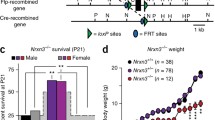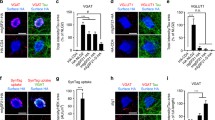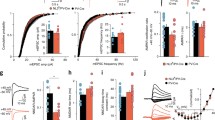Abstract
Neuroligins (NLs) are postsynaptic cell-adhesion proteins that play important roles in synapse formation and the excitatory-inhibitory balance. They have been associated with autism in both human genetic and animal model studies, and affect synaptic connections and synaptic plasticity in several brain regions. Yet current research mainly focuses on pyramidal neurons, while the function of NLs in interneurons remains to be understood. To explore the functional difference among NLs in the subtype-specific synapse formation of both pyramidal neurons and interneurons, we performed viral-mediated shRNA knockdown of NLs in cultured rat cortical neurons and examined the synapses in the two major types of neurons. Our results showed that in both types of neurons, NL1 and NL3 were involved in excitatory synapse formation, and NL2 in GABAergic synapse formation. Interestingly, NL1 affected GABAergic synapse formation more specifically than NL3, and NL2 affected excitatory synapse density preferentially in pyramidal neurons. In summary, our results demonstrated that different NLs play distinct roles in regulating the development and balance of excitatory and inhibitory synapses in pyramidal neurons and interneurons.





Similar content being viewed by others
References
Song JY, Ichtchenko K, Sudhof TC, Brose N. Neuroligin 1 is a postsynaptic cell-adhesion molecule of excitatory synapses. Proc Natl Acad Sci U S A 1999, 96: 1100–1105.
Gibson JR, Huber KM, Sudhof TC. Neuroligin-2 deletion selectively decreases inhibitory synaptic transmission originating from fast-spiking but not from somatostatin-positive interneurons. J Neurosci 2009, 29: 13883–13897.
Varoqueaux F, Jamain S, Brose N. Neuroligin 2 is exclusively localized to inhibitory synapses. Eur J Cell Biol 2004, 83: 449–456.
Budreck EC, Scheiffele P. Neuroligin-3 is a neuronal adhesion protein at GABAergic and glutamatergic synapses. Eur J Neurosci 2007, 26: 1738–1748.
Hoon M, Soykan T, Falkenburger B, Hammer M, Patrizi A, Schmidt KF, et al. Neuroligin-4 is localized to glycinergic postsynapses and regulates inhibition in the retina. Proc Natl Acad Sci U S A 2011, 108: 3053–3058.
Hoon M, Bauer G, Fritschy JM, Moser T, Falkenburger BH, Varoqueaux F. Neuroligin 2 controls the maturation of GABAergic synapses and information processing in the retina. J Neurosci 2009, 29: 8039–8050.
Poulopoulos A, Aramuni G, Meyer G, Soykan T, Hoon M, Papadopoulos T, et al. Neuroligin 2 drives postsynaptic assembly at perisomatic inhibitory synapses through gephyrin and collybistin. Neuron 2009, 63: 628–642.
Chih B, Engelman H, Scheiffele P. Control of excitatory and inhibitory synapse formation by neuroligins. Science 2005, 307: 1324–1328.
Levinson JN, Chery N, Huang K, Wong TP, Gerrow K, Kang R, et al. Neuroligins mediate excitatory and inhibitory synapse formation: involvement of PSD-95 and neurexin-1beta in neuroligin-induced synaptic specificity. J Biol Chem 2005, 280: 17312–17319.
Prange O, Wong TP, Gerrow K, Wang YT, El-Husseini A. A balance between excitatory and inhibitory synapses is controlled by PSD-95 and neuroligin. Proc Natl Acad Sci U S A 2004, 101: 13915–13920.
Chubykin AA, Atasoy D, Etherton MR, Brose N, Kavalali ET, Gibson JR, et al. Activity-dependent validation of excitatory versus inhibitory synapses by neuroligin-1 versus neuroligin-2. Neuron 2007, 54: 919–931.
Ko J, Zhang C, Arac D, Boucard AA, Brunger AT, Sudhof TC. Neuroligin-1 performs neurexin-dependent and neurexin-independent functions in synapse validation. EMBO J 2009, 28: 3244–3255.
Chanda S, Hale WD, Zhang B, Wernig M, Sudhof TC. Unique versus redundant functions of neuroligin genes in shaping excitatory and inhibitory synapse properties. J Neurosci 2017, 37: 6816–6836.
Blundell J, Blaiss CA, Etherton MR, Espinosa F, Tabuchi K, Walz C, et al. Neuroligin-1 deletion results in impaired spatial memory and increased repetitive behavior. J Neurosci 2010, 30: 2115–2129.
Blundell J, Tabuchi K, Bolliger MF, Blaiss CA, Brose N, Liu X, et al. Increased anxiety-like behavior in mice lacking the inhibitory synapse cell adhesion molecule neuroligin 2. Genes Brain Behav 2009, 8: 114–126.
Baudouin SJ, Gaudias J, Gerharz S, Hatstatt L, Zhou K, Punnakkal P, et al. Shared synaptic pathophysiology in syndromic and nonsyndromic rodent models of autism. Science 2012, 338: 128–132.
Varoqueaux F, Aramuni G, Rawson RL, Mohrmann R, Missler M, Gottmann K, et al. Neuroligins determine synapse maturation and function. Neuron 2006, 51: 741–754.
Tabuchi K, Blundell J, Etherton MR, Hammer RE, Liu X, Powell CM, et al. A neuroligin-3 mutation implicated in autism increases inhibitory synaptic transmission in mice. Science 2007, 318: 71–76.
Kwon HB, Kozorovitskiy Y, Oh WJ, Peixoto RT, Akhtar N, Saulnier JL, et al. Neuroligin-1-dependent competition regulates cortical synaptogenesis and synapse number. Nat Neurosci 2012, 15: 1667–1674.
Zhang B, Sudhof TC. Neuroligins are selectively essential for NMDAR signaling in cerebellar stellate interneurons. J Neurosci 2016, 36: 9070–9083.
Polepalli JS, Wu H, Goswami D, Halpern CH, Sudhof TC, Malenka RC. Modulation of excitation on parvalbumin interneurons by neuroligin-3 regulates the hippocampal network. Nat Neurosci 2017, 20: 219–229.
Cao M, Xu J, Shen C, Kam C, Huganir RL, Xia J. PICK1-ICA69 heteromeric BAR domain complex regulates synaptic targeting and surface expression of AMPA receptors. J Neurosci 2007, 27: 12945–12956.
Xu J, Xiao N, Xia J. Thrombospondin 1 accelerates synaptogenesis in hippocampal neurons through neuroligin 1. Nat Neurosci 2010, 13: 22–24.
Wang M, Li H, Takumi T, Qiu Z, Xu X, Yu X, et al. Distinct defects in spine formation or pruning in two gene duplication mouse models of autism. Neurosci Bull 2017, 33: 143–152.
Tian Y, Zhang ZC, Han J. Drosophila studies on autism spectrum disorders. Neurosci Bull 2017, 33: 737–746.
Foldy C, Malenka RC, Sudhof TC. Autism-associated neuroligin-3 mutations commonly disrupt tonic endocannabinoid signaling. Neuron 2013, 78: 498–509.
Graf ER, Zhang X, Jin SX, Linhoff MW, Craig AM. Neurexins induce differentiation of GABA and glutamate postsynaptic specializations via neuroligins. Cell 2004, 119: 1013–1026.
Zeidan A, Ziv NE. Neuroligin-1 loss is associated with reduced tenacity of excitatory synapses. PLoS One 2012, 7: e42314.
Boucard AA, Chubykin AA, Comoletti D, Taylor P, Sudhof TC. A splice code for trans-synaptic cell adhesion mediated by binding of neuroligin 1 to alpha- and beta-neurexins. Neuron 2005, 48: 229–236.
Scheiffele P, Fan J, Choih J, Fetter R, Serafini T. Neuroligin expressed in nonneuronal cells triggers presynaptic development in contacting axons. Cell 2000, 101: 657–669.
Fu Z, Washbourne P, Ortinski P, Vicini S. Functional excitatory synapses in HEK293 cells expressing neuroligin and glutamate receptors. J Neurophysiol 2003, 90: 3950–3957.
Yizhar O, Fenno LE, Prigge M, Schneider F, Davidson TJ, O’Shea DJ, et al. Neocortical excitation/inhibition balance in information processing and social dysfunction. Nature 2011, 477: 171–178.
Acknowledgements
This work was supported by grants from the National Natural Science Foundation of China (31571049 and 81561168022), the National Basic Research Program of China (2015CB910801), Zhejiang Provincial Natural Science Foundation of China (LR19H090001 and LD19H090002), a joint grant from the National Natural Science Foundation of China and the Research Grants Council of Hong Kong, China (8151101104 and N_HKUST625/15) and Fundamental Research Funds for the Central Universities of China. We appreciate the Core Facilities of Zhejiang University School of Medicine for technical support, and Mrs. SS Liu, ZXN Lin and GF Xiao for their help with confocal microscopy.
Author information
Authors and Affiliations
Corresponding authors
Ethics declarations
Conflict of interest
The authors declare that they have no conflict of interest.
Electronic supplementary material
Below is the link to the electronic supplementary material.
Rights and permissions
About this article
Cite this article
Xia, QQ., Xu, J., Liao, TL. et al. Neuroligins Differentially Mediate Subtype-Specific Synapse Formation in Pyramidal Neurons and Interneurons. Neurosci. Bull. 35, 497–506 (2019). https://doi.org/10.1007/s12264-019-00347-y
Received:
Accepted:
Published:
Issue Date:
DOI: https://doi.org/10.1007/s12264-019-00347-y




